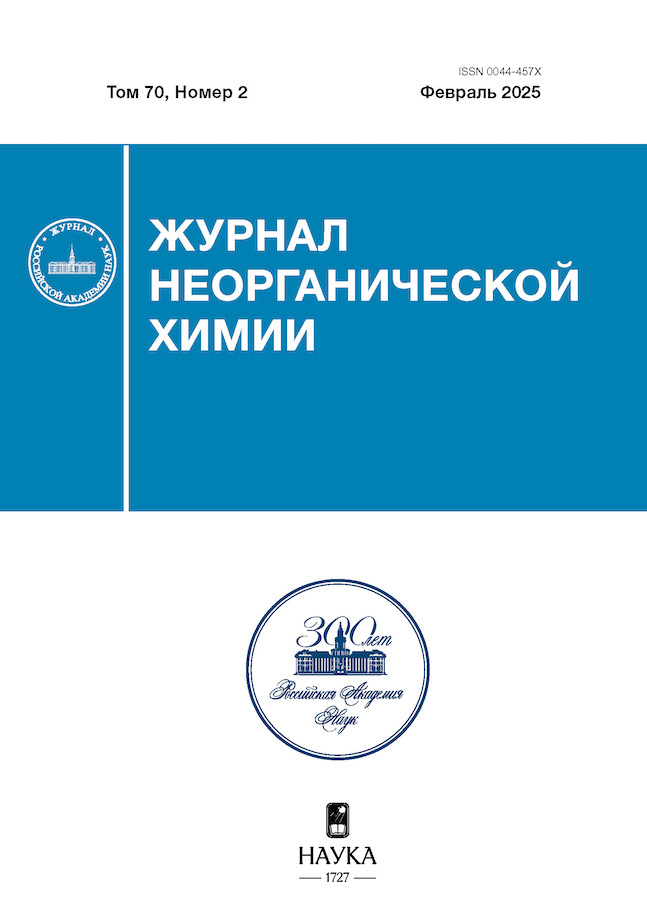Rapid hydrolysis of the CuSO4 salt solution microdroplets deposited on the alkaline solution and the formation of ordered arrays of open microspheres with Cu(OH)2 walls
- 作者: Golubeva A.A.1, Meleshko А.А.1, Tolstoy V.P.1
-
隶属关系:
- Saint Petersburg State University
- 期: 卷 70, 编号 2 (2025)
- 页面: 292-300
- 栏目: НЕОРГАНИЧЕСКИЕ МАТЕРИАЛЫ И НАНОМАТЕРИАЛЫ
- URL: https://ruspoj.com/0044-457X/article/view/683206
- DOI: https://doi.org/10.31857/S0044457X25020151
- EDN: https://elibrary.ru/IBVUCM
- ID: 683206
如何引用文章
详细
It was shown for the first time that open microspheres 1–10 µm in size with Cu(OH)2 walls and unique morphology are formed as reactions of rapid hydrolysis of copper (II) cations when microdroplets of aqueous CuSO4 solution are sprayed on the surface of alkaline solution of Na2SO4 at room temperature and without the use of surfactants. It has been shown that the microspheres formed under these conditions have a single hole in their walls with a size ranging from fractions to units of a micrometer and they are oriented on the surface of the alkaline solution with this hole facing towards the air. These microspheres can be transferred to various substrates using a vertical elevator technique, where they are deposited in layers with their holes predominantly oriented in the opposite direction from the substrate. It has been found that the walls of these microspheres are several hundred nanometers thick and are composed of a combination of Cu(OH)2 nanocrystals, and nanorods, with a diameter 5–10 nm and a length up to 500 nm. When the samples are heated in air at 150°C, these nanocrystals lose water and form CuO single crystals without significant changes in their morphology. It was found that applying layers of microspheres to the surfaces of various substrates gives it superhydrophilic properties.
全文:
作者简介
A. Golubeva
Saint Petersburg State University
Email: a.meleshko@spbu.ru
Institute of Chemistry
俄罗斯联邦, St. Petersburg, 198504А. Meleshko
Saint Petersburg State University
编辑信件的主要联系方式.
Email: a.meleshko@spbu.ru
Institute of Chemistry
俄罗斯联邦, St. Petersburg, 198504V. Tolstoy
Saint Petersburg State University
Email: a.meleshko@spbu.ru
Institute of Chemistry
俄罗斯联邦, St. Petersburg, 198504参考
- Pavlikov A.Y., Saikova S.V., Samoilo A.S. et al. // Russ. J. Inorg. Chem. 2024. V. 69. P. 265. https://doi.org/10.1134/S0036023623603057
- Zhang Q., Zhang K., Xu D. et al. // Prog. Mater. Sci. 2014. V. 60. P. 208. https://doi.org/10.1016/j.pmatsci.2013.09.003
- Батищева Е.В., Толстой В.П. // Журн. неорган. xимии. 2022. T. 67. № 6. C. 836. https://doi.org/10.31857/S0044457X22060058
- Zhu D., Wang L., Yu W. et al. // Sci Rep. 2018. V. 8. P. 5282. https://doi.org/10.1038/s41598-018-23174-z
- Sadale S.B., Patil S.B., Teli A.M. et al. // Solid State Sci. 2022. V. 123. P. 106780. https://doi.org/10.1016/j.solidstatesciences.2021.106780
- Андрийченко Е.О., Зеленов В.И., Бовыка В.Е. и др. // Журн. общ. химии. 2021. T. 91. № 4. С. 638. https://doi.org/10.31857/S0044460X2104020X
- Nevezhina A.V., Fadeeva T.V. // Acta Biomed. Sci. 2021. V. 6. № 6-2. P. 37. https://doi.org/10.29413/ABS.2021-6.6-2.5
- Nigussie A., Murthy A., Bedassa A. // Res. J. Chem. Environ. 2021. V. 25. № 6. P. 202.
- Rabbani M., Rahimi R., Bozorgpour M. et al. // Mater. Lett. 2014. V. 119. P. 39. http://dx.doi.org/10.1016/j.matlet.2013.12.095
- Umar A., Ibrahim A., Ammar H. et al. // Ceram. Int. 2021. V. 47. P. 12084. https://doi.org/10.1016/j.ceramint.2021.01.053
- Liu D., Liu Y., Bao E. et al. // J. Energy Storage. 2023. V. 68. P. 107875. https://doi.org/10.1016/j.est.2023.107875
- Wang J., Liu Y., Wang S. et al. // J. Mater. Chem. A. 2014. V. 2. P. 1224. https://doi.org/10.1039/c3ta14135g
- Jiao S., Zhang X., Zhang G. et al. // J. Mater. Chem. A. 2018. V. 7. P. 3084. https://doi.org/10.1039/C7TA10632G
- Kumar M.A., Debabrata P. // ACS Appl. Energy Mater. 2021. V. 4. № 9. P. 9412. https://doi.org/10.1021/acsaem.1c01632.s001
- Ma H., Tan Y., Liu Z et al. // Nanomaterials. 2021. V. 11. P. 104. https://doi.org/10.3390/nano11010104
- Liu X., Xiong H., Yang Y. et al. // ACS Omega. 2018. V. 3. P. 13146. https://doi.org/10.1021/acsomega.8b01299
- Meng D., Liu D., Wang G. et al. // Vacuum. 2017. V. 144. P. 272. http://dx.doi.org/10.1016/j.vacuum.2017.08.013
- Ai Y., Pang Q., Liu X. et al. // Nanomaterials. 2024. V. 14. P. 1145. https://doi.org/10.3390/nano14131145
- Molkenova A., Sarsenov S., Atabaev S. et al. // Environ. Nanotechnol., Monit. Manage. 2021. V. 16. P. 100507. https://doi.org/10.1016/j.enmm.2021.100507
- Cho Y., Huh Y. // Bull. Korean Chem. Soc. 2009. V. 30. № 6. P. 1410.
- Dong F., Guo Y., Zhang D. et al. // Nanomaterials. 2020. V. 10. P. 67. https://doi.org/10.3390/nano10010067
- Tolstoy V.P., Meleshko A.A., Golubeva A.A. et al. // Colloids Interfaces. 2022. V. 6. № 2. P. 32. https://doi.org/10.3390/colloids6020032
- Tolstoy V.P., Meleshko A.A., Danilov D.V. // Mendeleev Commun. 2024. V. 34. № 3. P. 430. https://doi.org/10.1016/j.mencom.2024.04.038
- Golubeva A.A., Kolesnikov I.E., Tolstoy V.P. // Ceram. Int. V. 50. № 24. P. 56025. https://doi.org/10.1016/j.ceramint.2024.11.025
- Zheng Q., Wei Y., Zeng X. et al. // Nanotechnology. 2020. V. 31. № 42. P. 425402. https://doi.org/10.1088/1361-6528/ab9f74
- Das S., Srivastava V.C. // Mater. Lett. 2015. V. 150. P. 130. http://dx.doi.org/10.1016/j.matlet.2015.03.018
- Zhang F., Huang S., Guo Q. et al. // Colloids Surf. 2020. V. 602. P. 125076. https://doi.org/10.1016/j.colsurfa.2020.125076
- Jaggi V.H., Oswazd H.R. // Acta Cryst. 1961. V. 14. P. 1041. https://doi.org/10.1107/S0365110X61003016
- Jansanthea P., Saovakon C., Chomkitichai W. et al. // Russ. J. Inorg. Chem. 2021. V. 66. P. 667. https://doi.org/10.1134/S0036023621050089
- Yin Y., Zhu L., Chang X. et al. // ACS Appl. Mater. Interfaces. 2020. V. 12. № 45. P. 50962. https://doi.org/10.1021/acsami.0c11677
补充文件














